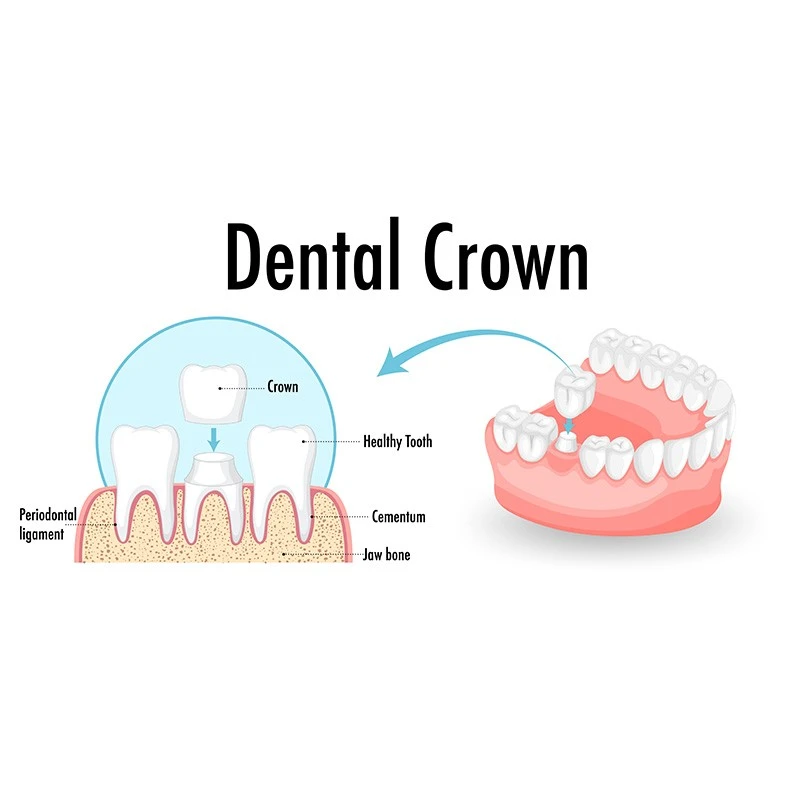
“Dental Crowns”
It is the use of a special material to "cover" the whole problem tooth. Which is mostly used on teeth that are decayed, cracked, or broken to the point where they cannot be filled. The main purpose of making dental crowns It is to preserve the remaining tooth pulp so that it does not become more damaged than before. At the same time, making the tooth that has that problem Come back strong and use it as usual. For example, when our teeth are very decayed, until the tooth decays and disappears, we will not be able to use our teeth normally. It will feel tingling and painful, and food particles can easily get stuck. If you continue to use it, it will increase the chance that the tooth will decay, crack, or break even more. Until finally, that tooth may have to be extracted. If we don't want to lose our teeth, I don't want to have to wear dentures. Dental crowns are the solution that will help us preserve that tooth. It also helps to restore the effective use of those teeth.
Who is a dental crown suitable for?
In fact, anyone who has a problem with tooth decay, cracked teeth, or chipped teeth that cannot be fixed with a filling. All teeth can be crowned. Because if the need for treatment is not wanting to lose that tooth and want to return to using teeth effectively Crowns are the most suitable method of tooth repair. This can be done on all teeth. Both the front teeth are focused on covering to restore beauty. and back teeth, or molars, that focus on chewing. However, in some cases, the root of the tooth may need to be examined first to see if there is a problem. If there is a problem with the root of the tooth, it should be treated first. Then slowly make a crown for the tooth. Because if the tooth is crowned and the tooth root has a problem in the end, it can cause problems with tooth decay or tooth sensitivity later. And the covered tooth must be removed in order for the root canal to heal properly. Before crowning the tooth again, which is considered a redundant treatment and causes unnecessary expenses to be incurred more than before.
What materials are used in dental crowns? What are the different advantages of each?
Making the crown A variety of materials can be used. Each type has different advantages. The expenses are also different. Currently, there are materials that are commonly used to make dental crowns, as follows:
- Dental crowns made from all metal (Full Metal Crown: FMC) are dental crown materials that are outstanding in their strength and durability. Therefore, it is most suitable for use in making crowns and treating molars, which have the main function of chewing. To return to using your teeth to chew food as efficiently as before However, one consideration for all-metal crowns is It's about the color of the material. that will look like a metallic and mixed gold color. Therefore, when covering it, the color of the teeth will not be a natural color that blends in with other teeth. But because it is often used to treat molars that are on the inside, Therefore, it may not affect the image much. Because the opportunity to see it is very small.
- Crowns made from resin (All-Resin Crown) are often popularly used for making crowns. Preserve the front teeth as much as possible. Because the resin material is clear, beautiful, and blends naturally with the color of other teeth, but if comparing their strength, they are still considered inferior to metal crowns. As a result, it is not very popular for use in making crowns to treat molars. Or how many teeth are in the back?
- Dental crowns are made from ceramic-coated metal. (Porcelain-Fused-to-Metal Crown: PFM) is a combination of the strength advantages of metal. and the beautiful, natural colors of ceramics to get a crown that is both strong and has the most beautiful color. However, using ceramic-coated metal crowns Extra tooth tissue must be milled out. To be able to place crowns effectively
- All-Ceramic Crowns (All-Ceramic Crown: ACC) are crowns that are both beautiful and strong. Suitable for people allergic to metal. However, it is not suitable for patients who have a habit of grinding their teeth. Or like to use your teeth to bite things. This is because ceramic is still not as strong as metal crowns. Crowns made entirely from ceramic can be divided into two sub-categories according to the material used: glass-ceramic crowns. They are outstanding in their beauty compared to other types of crowns. and zirconia crowns that are stronger than general ceramic crowns.
- Dental crowns made from stainless steel (Stainless Steel Crown: SSC) are dental crowns that are outstanding in not rusting. They are easy to make and do not take much time. No need to type your mouth. Therefore, it is commonly used on primary teeth in children. This is because children will not have the patience to undergo long and complex dental procedures like adults.
Making the crown It is not a dental treatment that can be completed in one day, like tooth extraction. or tooth filling, but there will be steps to take. In order to get the best results, follow these steps:
1. Examine, take history, and take impressions of your mouth to make a temporary crown.
On the first day of the meeting to get the crown made, the dentist will take a history. Check for tooth problems that need to be corrected, check bites, and take x-rays to see the condition of the tooth roots. Examine the dentin. To evaluate whether or not a crown can be made After being confident that a crown can be made, the doctor will take an impression of your mouth to send for a temporary crown.
2. Teeth grinding and mouth impressions to make permanent crowns.
After the first day of having your mouth printed, the doctor will make an appointment to see you again, inject anesthesia, grind your teeth, and select the appropriate tooth color. Before taking another impression of the mouth to send for a permanent crown. While waiting for the permanent crown the doctor will place the temporary crown on the patient at the first visit.
3. Put on a real crown.
When the permanent crown is completed the doctor will make an appointment to remove the temporary crown and place a permanent crown. This may involve a little grinding of the tooth to make the crown fit properly. After the permanent crown is completed, there will be an examination of the bite. Check for completeness. Before using dental glue to secure the permanent crown as tightly as possible
4. Make an appointment to follow up on symptoms.
Approximately 1 week after the permanent crown has been placed, the doctor will make an appointment for the patient to come in and check the condition of the tooth. Take a history and ask whether there are any unusual symptoms. Can I use my teeth well? along with checking overall oral health. If nothing is wrong, the doctor will make an appointment to check the condition of the teeth approximately every 6 months.หลังจากการใส่ครอบฟันถาวรแล้วประมาณ 1 สัปดาห์ แพทย์จะนัดหมายคนไข้เข้ามาตรวจเช็กสภาพฟัน ซักประวัติสอบถามอาการว่ามีอาการผิดปกติหรือไม่ สามารถใช้ฟันได้เป็นอย่างดีหรือไม่ พร้อมทั้งตรวจเช็กสุขภาพช่องปากโดยรวมทั้งหมด หากไม่มีอะไรผิดปกติ แพทย์จะนัดหมายมาตรวจสภาพฟันอีกประมาณทุกๆ 6 เดือน
How do you take care of your crown to keep your mouth healthy?
In general, the average lifespan of a “crown” is approximately 5–15 years, depending on the patient's usage. If the patient takes care of their teeth, their oral health is good. Don't chew ice. Do not chew hard things, use your teeth to bite, or tear any packaging. The lifespan will be longer. Many people often misunderstand that with a crown, the tooth will not decay. Because there is a crown to help protect the tooth. But in reality, teeth can still decay if you don't take good care of your mouth. Therefore, after getting a crown, you should always pay attention to oral hygiene. Especially in the teeth that are being crowned. You may use dental floss to help. In order to clean more thoroughly, In addition to that, you should see a dentist for a regular oral health check every 6 months in order to detect any abnormalities related to oral disease. So that it can be treated and corrected as soon as possible.
Dental crowns are the process of making problem teeth strong, beautiful, and functional again. But it doesn't mean that the teeth will be 100 percent normal. And we still have a chance of losing that tooth. If we don't maintain good dental health, then the best way is to take care of our teeth to be healthy from the beginning. Our teeth will not decay, be broken, or become chipped until they need to be repaired with a crown. We will have strong, beautiful, natural teeth that can be used for a long time.

